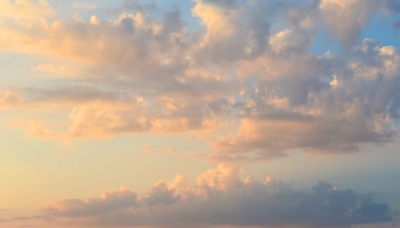
Clouds are created when water vapor, an invisible gas, turns into liquid water droplets. These water droplets form on tiny particles, like dust, that are floating in the air.
You hang up a wet towel and, when you come back, it’s dry. You set out a bowl of water for your dog and when you look again, the water level in the bowl has dropped even though Woofy has been nowhere near the bowl.
Where did the missing water go? It evaporated. That means some of the liquid water in the towel or bowl changed into an invisible gas called water vapor and drifted away into the atmosphere. (Notice that “evaporated” contains the word “vapor.”)
The same thing is constantly happening with oceans, lakes, rivers, swamps, swimming pools – and everywhere water is in contact with air.
Liquid water changes into a gas when water molecules get extra energy from a heat source such as the Sun or from other water molecules running into them. These energetic molecules then escape from the liquid water in the form of gas. In the process of changing from liquid to gas, the molecules absorb heat, which they carry with them into the atmosphere. That cools the water they leave behind.
The air can only hold a certain amount of water vapor, depending on the temperature and weight of the air – or atmospheric pressure – in a given area. The higher the temperature or atmospheric pressure, the more water vapor the air can hold. When a certain volume of air is holding all the water vapor it can hold, it is said to be “saturated.”
What happens if a saturated volume of air cools or the atmospheric pressure drops? The air is no longer able to hold all that water vapor. The excess amount changes from a gas into a liquid or solid (ice). The process of water changing from a gas to a liquid is called “condensation,” and when gas changes directly into a solid, it is called “deposition.” These two processes are how clouds form.
Condensation happens with the help of tiny particles floating around in the air, such as dust, salt crystals from sea spray, bacteria or even ash from volcanoes. Those particles provide surfaces on which water vapor can change into liquid droplets or ice crystals.
A large accumulation of such droplets or ice crystals is a cloud.
Credit : Climate Kids
Picture Credit : Google




